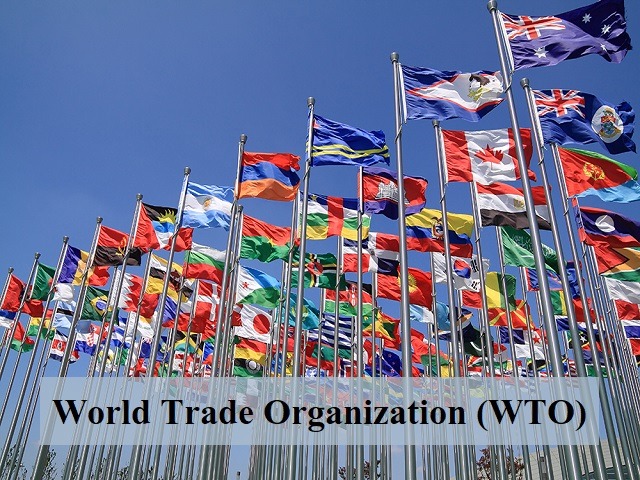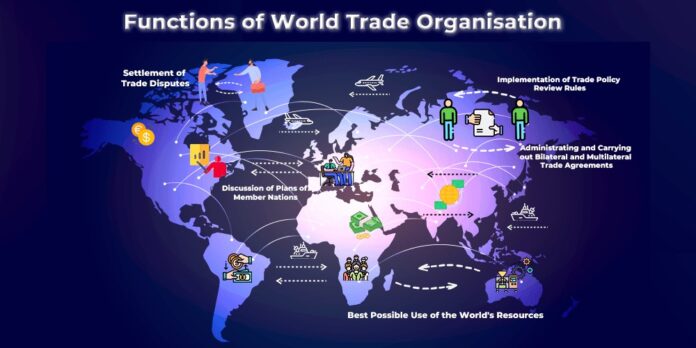The primary authority that works at international level to regulate the trade is the World Trade Organization in short form WTO. It was established in 1995. The question could come to mind that whether it is interfering in the sovereign nature of the state like states are sovereign they could decide for themselves then how there is an authority which regulates states action.

Sovereignty vs. Cooperation: countries are sovereign states with the authority to make their own laws and policies. So, how does the WTO function without infringing on this sovereignty?
The WTO does not dictate the laws: It lays down a framework of trade agreements to which the Member countries agree voluntarily. These agreements define the ground rules for fair trade practices and how to resolve disputes.
It is Balancing interests: The countries basically give up some control over certain aspects of their trade policies in return for the benefits like:
- Market access: Easy access to other countries’ markets for their exports.
- Fair competition: This prevents dumping or the act of selling goods below cost.
- Dispute settlement: A neutral forum to resolve trade disagreements peacefully.
The need for the WTO thus emanated from the desire to avoid the trade wars and instability that characterized the pre-WWII era. A deeper look follows into the historical context:
- Pre-WWII Trade: Trade was usually obstructed by high tariffs, quotas, and other restrictions.
- Trade Wars: The countries would retaliate by imposing high tariffs on the goods of the other nation, thereby creating an downwards spiral from which there is no win-win situation. This created part of the prelude to the economic instability that led to WWII [2].
- Post-WWII Vision: From the ashes of WWII came the need and longing for international cooperation as a step towards avoiding future wars. Trade was seen as a driver for peace and prosperity.
The General Agreement on Tariffs and Trade (GATT), formed in 1947, was a move toward a much regulated trading system. The WTO, operative from the year 1995, was based on the GATT platform. It incorporated:
- Lower Trade Barriers: A motive of the WTO was to bring those down even further through constant negotiating and reaching agreements. This would lead to:
- Lower prices to consumers as a result of higher competition.
- Economic growth for the member countries by means of increased trade and investments.
- Dispute Settlement: There was a setup by the WTO about peaceful and rule-based settlement of trade disputes between its member countries. This helped block unilateral actions and retaliation.
- Fairness and Transparency: The WTO came in to make the trading system fairer and more transparent, with all its member voices and benefits in trade.
Although WTO has been criticized in recent years, the establishment of it was impelled by a global imperative for a more stable and predictable international trading environment to promote economic growth and prevent future conflict.

WTO is a intergovernmental organization. WTO is not directly part of the UN but cooperates with the UN system. Its headquarter is situated in Geneva, Switzerland. It has 164 member states, covering more than 98% of world trade and GDP.
Functions of WTO are as follows:
1). Sets and amends regulations on international trade [1].
2). Provides a platform on which countries could undertake negotiations for the reduction in trade barriers, such as tariffs and quotas [1].
3). Manages dispute settlement procedures to ensure its members abide by the trading treaties.
The World Trade Organization (WTO) doesn’t have a physical body in the same way a human does. However, it has a well-defined structure that oversees its various functions. Here’s a breakdown of the WTO’s main components:
Ministerial Conference : Highest decision-making body, meeting every two years to set the overall direction and priorities of the WTO. All member countries are represented.
General Council: It acts as the WTO’s executive body, overseeing day-to-day operations and implementing decisions made by the Ministerial Conference. It also functions as a forum for negotiations and dispute settlement.
Councils and Committees: Several councils and committees handle specific areas like trade in goods, services, intellectual property, and trade and development. These bodies provide technical expertise and recommendations.
Secretariat: Provides administrative and technical support for the WTO’s various activities. It also houses the dispute settlement system.
Dispute Settlement Body (DSB):Oversees the WTO’s dispute settlement process, where members can challenge each other’s trade policies. (This function is currently facing challenges due to the lack of new appointments to the Appellate Body)
Trade Policy Review Body (TPRB): Regularly reviews the trade policies and practices of member countries.
By working together, these components ensure the smooth functioning of the WTO in regulating international trade
At the heart of matters, WTO is the referee in international trade and ensures there is fair competition and easier trade flow amongst all the countries involved. There are other international players too with whom WTO co-operate. We will discuss each in the upcoming video. Hope you learnt something from this video. Keep learning keep growing.


